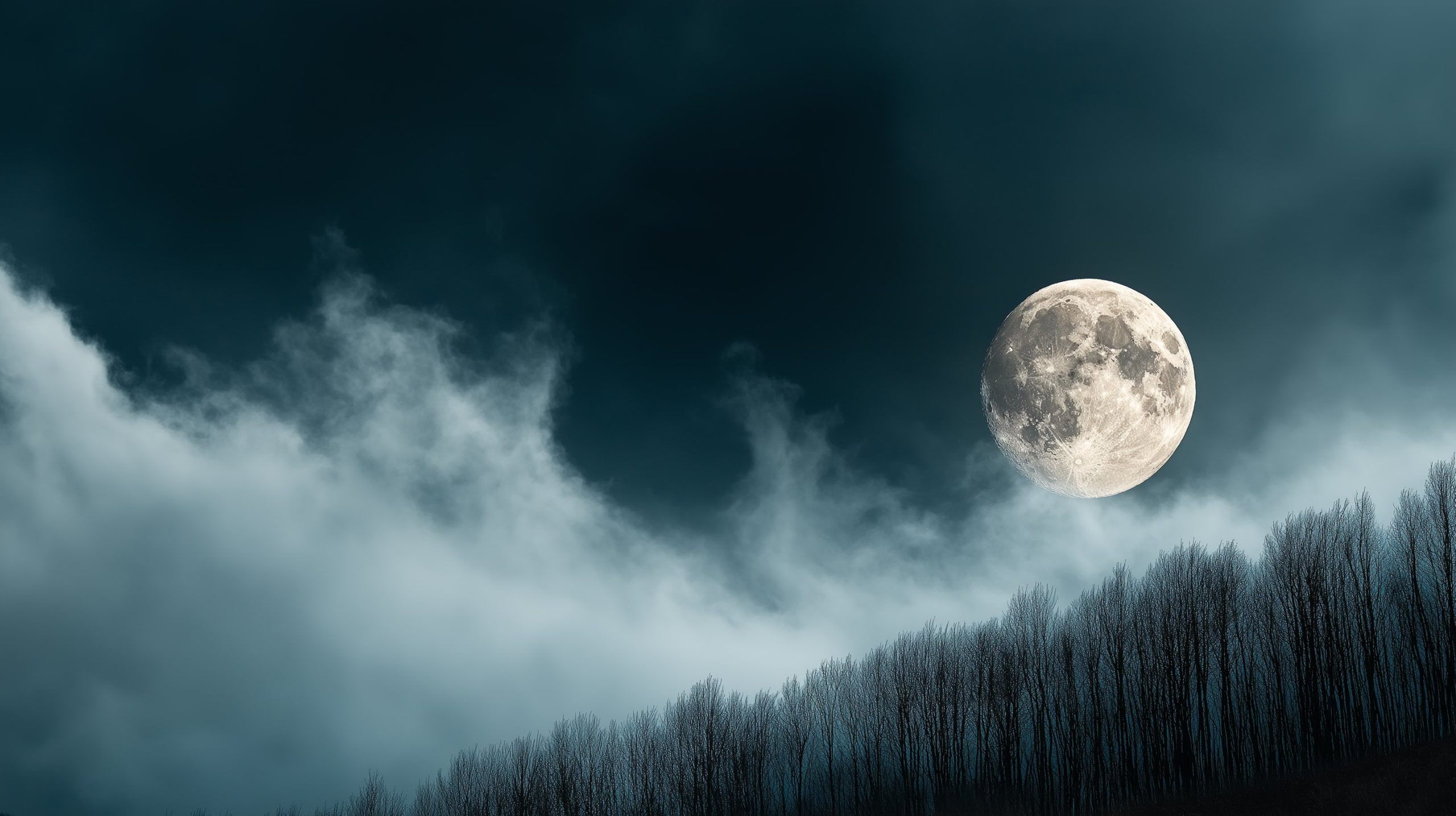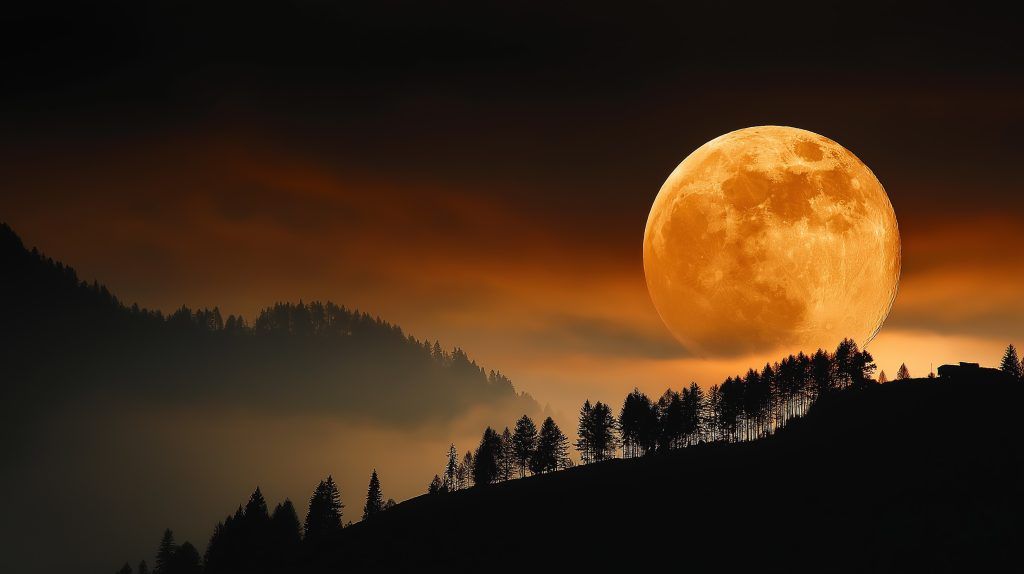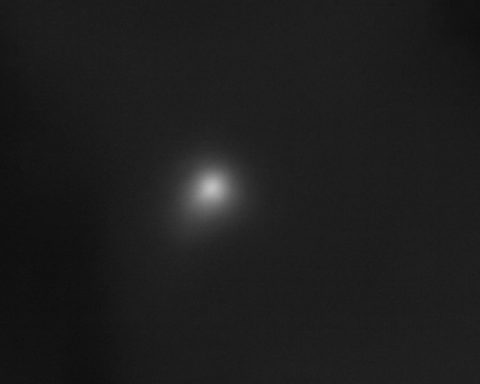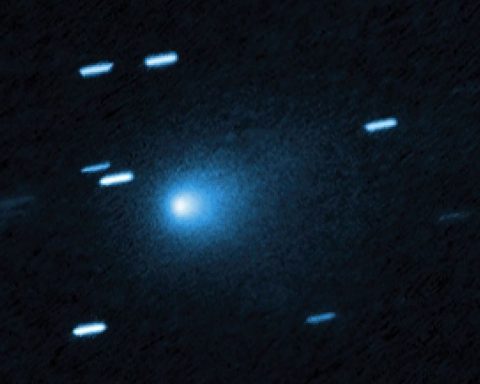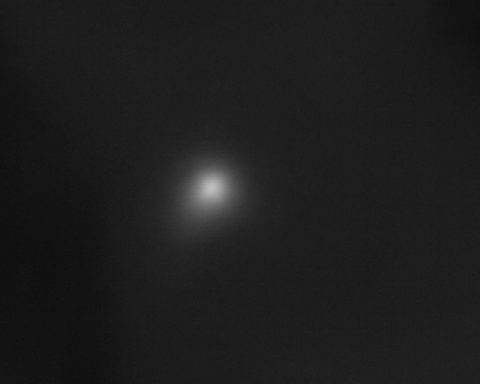- The December 4, 2025 full Moon, known as the Cold Moon, peaks at 23:15 UTC (6:15 p.m. EST; 3:15 p.m. PST in Los Angeles).
- This full Moon is a supermoon, about 7–8% larger in apparent size and roughly 15% brighter than a typical full Moon.
- It is the final in a series of three back-to-back 2025 supermoons, following October and November events.
- It is the closest full Moon to the winter solstice in 2025, though it occurs a couple weeks before the solstice and is also called the Long Night Moon.
- Because the Moon is at perigee, tides around the full Moon will be slightly higher than average (perigean spring tides).
- Moonrise on December 4 occurs around local sunset, with the Moon low on the eastern horizon and climbing toward the zenith at midnight in mid-northern latitudes.
- On December 4–5, the Moon will be near the Pleiades star cluster in Taurus, offering a striking pairing in binoculars.
- On December 7, the 89%-illuminated waning gibbous Moon will pass within about 3° of Jupiter in Gemini.
- The Geminid meteor shower peaks on December 13–14, with about 100–150 meteors per hour under dark skies, while the Moon is a waning crescent (~27% illuminated).
- The Ursid meteor shower peaks on December 22–23 with about 5–10 meteors per hour in a nearly moonless night (~6% moon illumination).
The last full moon of 2025 is set to put on a spectacular show. December’s full moon – traditionally known as the Cold Moon – will rise as a supermoon, appearing slightly larger and brighter than usual. This celestial event comes with rich cultural lore, ideal viewing conditions (weather permitting), and a few extra treats for skywatchers. Below, we detail when to see it, why it’s special, and what experts say about this luminous lunar finale of 2025.
When and Where to See December 2025’s Full Moon
Mark your calendars: the full Cold Moon occurs on Thursday, December 4, 2025, and it reaches peak illumination at 23:15 UTC. That corresponds to 6:15 p.m. Eastern Standard Time (EST) in the U.S. [1]. In practical terms, observers in North America can watch the Moon rise around sunset on Dec. 4 and see it become perfectly full by early evening. For those on the U.S. West Coast, peak fullness comes at 3:15 p.m. Pacific Time, meaning the moon will technically turn full before it even rises on that date (so it will appear essentially full at moonrise) [2]. In the UK (GMT), the moment of full Moon falls late at night on Dec. 4 (about 11:14 p.m. GMT [3]), while in time zones east of Europe it will occur after midnight – i.e. early on December 5 locally.
Keep in mind that a full moon looks nearly round for about a day before and after the exact moment of fullness. So, on both December 4 and 5 the Moon will appear fully illuminated in the sky to the casual eye. The moonrise on Dec. 4 will occur around local sunset, and the Moon will stay visible all night long, setting near sunrise on Dec. 5. Wherever you are, plan to look toward the east around sunset on December 4 to catch the Moon low on the horizon as it rises. The rising full moon often looks especially large and golden-hued – a gorgeous sight that results from atmospheric optics and our own eyes’ comparison with foreground objects (an effect known as the “moon illusion” [4] [5].
Global time zone check: At the exact moment of full moon (Dec 4, 23:15 UTC), it will be 6:15 p.m. in New York, 5:15 p.m. in Chicago, 3:15 p.m. in Los Angeles, 11:15 p.m. in London, 8:15 a.m. (Dec 5) in Sydney, and 6:45 a.m. (Dec 5) in New Delhi. No matter the time zone, the full moon’s beauty will be accessible to anyone with a clear sky and a view to the east that evening.
Why Is It Called the “Cold Moon”?
Many cultures name each full moon, and December’s carries some of the most evocative titles. In North America and much of Europe, the December full moon is commonly called the “Cold Moon.” The name is fitting – December is when winter’s cold truly begins to set in across the Northern Hemisphere [6]. Long nights and frigid weather characterize this time, and the Moon’s name reflects that reality. According to the Old Farmer’s Almanac and other sources, the term “Cold Moon” likely has Native American origins (often attributed to the Mohawk or other Algonquin-speaking peoples) and was later adopted into colonial American folklore.
This moon is also often called the “Long Nights Moon,” since it occurs near the winter solstice when nights are longest. In fact, the Old English and Anglo-Saxon name for December’s full moon was “the Moon Before Yule,” connecting it to winter solstice festivals (Yule) [7]. Another ancient English name is the “Long Night Moon,” acknowledging that around the solstice the full moon stays in the sky for a long time on these lengthy nights [8] [9].
Other traditional names abound. Some European pagan traditions dubbed it the “Oak Moon,” possibly alluding to the sacred oak in winter [10]. In some Chinese lore it’s referred to as the “Bitter Moon,” and a medieval English name for the late-year full moon was indeed “Oak Moon.” Even more names emerge from various cultures: for example, the Cherokee people have reportedly called the December full moon the “Snow Moon” (though other sources use that name for February) [11]. And because seasons are opposite in the Southern Hemisphere, a full moon in December down under occurs during summer – there, traditional names for this moon include “Strawberry Moon” or “Honey Moon,” borrowing the titles used in the Northern Hemisphere’s June [12]. No matter the name, they all highlight the seasonal backdrop: in the north, December’s moon shines over a landscape of frost and long, dark nights, while in the south it presides over warm summer evenings.
“Known in the Farmer’s Almanac as the Cold Moon, the Long Night Moon, and the Moon Before Yule, the event comes as the December full moon coincides with the body’s close approach to Earth.” – The Guardian, science editor Ian Sample, describing a December supermoon’s traditional names [13].
These age-old names underscore how significant the full moon was for timekeeping and seasonal rituals. For centuries, people tracked the passage of time by full moons, and the names served as reminders of each period’s characteristics [14]. Even today, using names like Cold Moon or Long Night Moon connects us with those cultural traditions and the natural cycle of the year.
A Supermoon Spectacle – Bigger, Brighter, But How Much?
This December 2025 full Moon is not only the last full moon of the year – it’s also the last in a series of three full supermoons that occurred back-to-back in Oct, Nov, and Dec 2025 [15]. A supermoon occurs when a full moon coincides with the Moon’s closest approach to Earth in its elliptical orbit (perigee). As a result, the Moon appears a bit larger in diameter and brighter in luminosity than an average full moon. December’s Cold Moon will indeed be a supermoon, roughly 7–8% larger in apparent size and about 15% brighter than a typical full Moon [16] [17]. In fact, the Royal Observatory Greenwich notes that the difference between the biggest full moon of the year and the smallest can be noticeable side-by-side, but to the casual observer a supermoon is only modestly more impressive than usual [18].
How big and bright are we talking? For comparison, astronomy experts explain that a perigee full moon (closest point) versus an apogee full moon (farthest point) can show about a 14% difference in apparent diameter and up to 30% difference in brightness [19]. However, compared to an average full moon, a typical supermoon is only on the order of ~7% larger and 15% brighter [20]. In the case of the December 4, 2025 supermoon, Star Walk’s calculations indicate it will be about 7.9% larger and 15% brighter than a regular full Moon [21]. This uptick in brilliance is enough to be measurable with instruments, but your eyes might not discern it without a direct comparison.
“It’ll be slightly bigger and brighter, but whether you can tell that from looking at it without an average full moon to compare is a moot point.” – Dr. Marek Kukula, astronomer at Royal Observatory Greenwich [22]
In other words, don’t expect a dramatically swollen “giant” moon – the supermoon effect is subtle. Many skywatchers agree that the main difference is psychological: knowing it’s a supermoon adds excitement, and seeing the Moon loom just above the horizon (where foreground objects make it look huge) can feel extra special. “A full moon is always a really lovely sight to see,” notes Dr. Kukula. “As the moon rises… you’ll get a feeling that this is a big-looking moon.” [23] The combination of the moon illusion and the supermoon status will make this Cold Moon a stunning spectacle.
Notably, December 2025’s Cold Moon is the final supermoon of 2025 [24]. After this, the next full supermoons will occur in 2026, but not immediately – the following year’s schedule has its supermoons in January, then not again until late in the year [25] [26]. That makes the Cold Moon a “grand finale” of the year’s lunar events. It’s also the closest full moon to the winter solstice (though occurring a couple weeks before it in 2025), which historically adds to its lore as the Long Night Moon.
Because the Moon will be at perigee, tides will be slightly higher than average in the days around the full moon (so-called perigean spring tides). Coastal communities might notice a few extra inches of tidal range. But these effects are minor. NASA scientists reassure that there’s nothing to fear or mystically unusual about a supermoon – aside from enjoying a beautiful bright Moon. “There should be nothing unusual except maybe more people staring up at the Moon, which should be a wonderful thing,” says NASA lunar geologist Noah Petro [27]. In short, the biggest impact of a supermoon is that it gets more of us out to appreciate our cosmic neighbor.
Skywatching Conditions and Celestial Highlights
December’s long, dark nights actually create excellent viewing conditions for a bright full moon. In the Northern Hemisphere, the Cold Moon will take a very high path across the sky, because full moons near the winter solstice rise much higher overhead than in other seasons. (This is the opposite of the sun’s low winter path; the full moon is directly opposite the sun’s position.) Observers in mid-northern latitudes will see the Cold Moon climb toward the zenith at midnight, “nearly to the top of the sky, just as the sun does near the June solstice” [28]. That high trajectory means the Moon stays above the horizon longer than usual – essentially “lighting up the longest nights” of the year. In fact, at high latitudes the Moon will be above the horizon for almost 15 hours around the full-moon date [29], providing generous moonlight through the night’s entirety. (This is why it’s called Long Night Moon!) By contrast, in the Southern Hemisphere (where it’s summer), the December full moon stays lower in the sky and for a shorter duration, mimicking the behavior of a winter sun [30].
For most viewers, the best time to enjoy the Cold Moon will be shortly after it rises on Dec. 4. Moonrise occurs around local sunset, give or take some minutes depending on your latitude. Watching the full moon rise in the east while the sun sets in the west is a delightful experience. The Moon often appears orange or reddish at the horizon, because you’re seeing it through the thicker layers of Earth’s atmosphere (which scatter blue light and let the red hues through) [31]. As it climbs higher in the sky, the Moon will turn its familiar bright white. Moonset the next morning (Dec. 5) around sunrise can be equally beautiful, if you’re up early – the big silvery orb will descend in the west while dawn breaks.
Thanks to the supermoon factor, the Cold Moon will be one of the brightest moonlights of the year. If you’re in a dark rural area with snow on the ground, expect the landscape to be illuminated in a serene, pale glow. (Some wildlife may be more active under the full moon, and you might even see moon shadows cast by trees.) Urban skywatchers will also notice the Moon’s brilliance – it will outshine all but the very brightest stars and planets. In fact, on Dec. 4–5 the Moon will be in the constellation Taurus, not far from the glittering Pleiades star cluster (also known as the Seven Sisters). At full phase the Moon’s glare may wash out the Pleiades to the naked eye, but if you position yourself so a building or tree blocks the Moon itself, you might still spot the cluster nearby. According to Star Walk, on the night of Dec. 4 the Moon appears close to the Pleiades – a lovely pairing in binoculars [32].
Around the same time, the giant planet Jupiter will be visible not far from the Moon. By December 2025, Jupiter shines brilliantly in the evening sky (in the constellation Gemini). A few nights after the full moon – on December 7 – the Moon will actually swing close to Jupiter in the sky, an 89%-illuminated waning gibbous Moon passing within about 3° of the planet [33] [34]. If you have clear skies on Dec. 7, look for the almost-full Moon and a bright star-like point (Jupiter) near it – a beautiful conjunction that’s easy to spot.
December 2025 also offers other astronomical treats. Mid-month, the Geminid meteor shower – one of the year’s most prolific meteor displays – peaks on the night of December 13–14. Fortunately, the Moon will be a waning crescent by then (only ~27% illuminated) [35], so its light won’t interfere much with meteor observing. Under dark skies, the Geminids can produce around 100–150 “shooting stars” per hour at peak [36]. If you’re out late, you might catch a few Geminid meteors zip across the sky even with the post-full Moon hanging around in the days just after the 4th, but the shower’s real show comes later in the month when the moonlight is dimmer.
Just after the solstice, on Dec 22–23, a smaller meteor shower called the Ursids reaches its peak (only about 5–10 meteors per hour in a dark sky). Conveniently, in 2025 the Ursids coincide with a nearly moonless night (only ~6% moon illumination) [37], so although this is a minor display, anyone keen enough to brave the cold predawn of Dec. 23 could see a few meteors emanating from the Ursa Minor region [38].
Finally, note that December 21, 2025 is the date of the solstice (winter solstice in the north, summer in the south) [39]. While not directly related to the full moon, it’s an important seasonal milestone just a couple of weeks after the Cold Moon. Many cultures celebrate festivals of light around this time – and a bright full moon fits right in with those themes.
Expert Tips: Enjoying the Full Moon (and What NASA Says)
Astronomers and experts emphasize that a full moon is one of the most accessible celestial events – no telescope or special equipment needed. “Simply walk outside and look up,” encourages NASA’s Noah Petro, who also notes that the best time is when the Moon is near the horizon, right after it rises (or before it sets) for added visual drama [40] [41]. If you want to photograph the Cold Moon, try to include some foreground scenery (like a skyline, trees, or mountains) when the Moon is low – this gives a sense of scale and the wow factor of a lunar disk looming over the horizon.
One important factor is weather. December weather can be fickle, especially in northern regions – clouds could always spoil the view. If December 4 is cloudy for you, don’t despair; the Moon will appear nearly full on the 5th as well, so you might get a second chance. “The difference in distance from one night to the next will be very subtle, so if it’s cloudy on Sunday, go out on Monday,” advised Noah Petro during a past supermoon, stressing that one day’s delay hardly changes the experience [42]. In other words, plan for the closest clear night around the full moon to enjoy it.
“There should be no impact on anybody on Earth… There should be nothing unusual except maybe for more people staring up at the Moon, which should be a wonderful thing.” – Noah Petro, NASA planetary geologist, on the hype around supermoons [43]
If the weather absolutely refuses to cooperate, you can also tune into online skywatching events. Astronomy groups often host live streams of the full moon rising over scenic locations. (For example, the Virtual Telescope Project frequently streams full moon views through telescopes). Back in 2017, when a Cold Moon supermoon occurred, a live webcast by Slooh observatory was set up to showcase it for those under clouded skies [44]. Keep an eye on NASA or observatory social media channels as well – they may share stunning images after the fact.
From a safety perspective, observing the full moon is completely safe for your eyes (unlike solar observing). The Moon’s brightness at full phase is intense but not harmful – at most, you might find it glarey through binoculars. If using binoculars or a telescope, a moon filter can reduce brightness and help you see lunar details even at full phase. (Though due to the direct head-on sunlight, a full moon actually shows less contrast on crater details than a half moon does; the surface looks somewhat flat. Many astronomers prefer viewing the Moon around its quarter phases to see mountains and craters in sharp relief.)
And yes, the full moon might affect some creatures – you may hear wolves howling (hence January’s “Wolf Moon” name) or notice that it’s harder to spot faint stars in the moonlit sky. But any effects on human behavior are minimal; despite urban legends about full moons and lunacy, studies have found little statistical correlation between full moons and odd human events [45]. So you can venture out in the moonlight without worry – perhaps just bundle up warmly, as befits the Cold Moon!
The Science Behind the Full Moon
Astronomically, a full moon occurs at a very specific moment: when the Moon stands exactly opposite the Sun from Earth’s perspective. In this alignment (called syzygy), Earth is positioned directly between the Sun and the Moon [46]. The Sun’s rays fully illuminate the Moon’s Earth-facing side, making the Moon appear as a perfect bright disk in our sky. Essentially, the Moon is 180° away from the Sun in the sky – which is why a full moon rises around sunset and sets around sunrise. This configuration happens roughly once every 29.5 days, which is the length of a full lunar phase cycle from one full moon to the next [47].
It’s worth noting that this opposition alignment is usually slightly imperfect – the Moon often passes a bit above or below Earth’s shadow at full moon. That’s why we don’t get a lunar eclipse every month. In 2025, for example, there were two total lunar eclipses (in March and September) when the full moons lined up just right with Earth’s shadow [48] [49]. The December 4, 2025 full moon does not result in an eclipse, because the Moon will miss Earth’s central shadow. But when those occasional “Blood Moon” eclipses do happen, it’s during a full moon – adding another layer of spectacle.
During a full moon, the Moon’s gravitational pull on Earth combines with the Sun’s gravitational pull (since the Sun and Moon are on opposite sides of Earth). This alignment leads to spring tides, which are the highest (and lowest) tides of the lunar month. Around the Cold Moon, coastal communities may experience a pronounced high tide – sometimes called a “king tide” when it’s especially extreme – though in most cases the difference is only a few extra inches of water height [50] [51]. Aside from tides, the full moon’s brightness can affect nocturnal wildlife behavior (predators have more light to hunt by, for instance), and many people report slightly poorer sleep on full moon nights – a topic of ongoing study and some debate.
From a cultural and historical perspective, the full moon has always been significant. As mentioned, the term “month” has its root in “moon” – because the ancient concept of a month was based on the lunar cycle. Communities used the predictable return of each full moon to keep track of seasons, plantings, harvests, and rituals. Even today, many calendars (such as the Chinese, Islamic, and Hebrew calendars) are based on lunar months. The December full moon, in particular, often aligns with winter solstice celebrations: for example, the Yule festival in old Germanic tradition or the Buddhist Uduvapa Poya in Sri Lanka (which commemorates an event in the Buddha’s life during the December full moon). In 2025, December’s full moon falls a couple of weeks before Christmas and New Year’s, adding to the festive atmosphere of the season.
Scientists also point out that the full moon is an opportunity to appreciate our nearest celestial neighbor and reflect on our place in space. The Moon is about 384,000 km away on average, and during this full moon it will be around 357,000 km away (near its closest). That reminds us that the Moon varies in distance and that its orbit is elliptical.
Interestingly, NASA and other space agencies are actively studying the Moon and planning future missions. By late 2025, NASA’s Artemis program is expected to be well underway, with the goal of landing astronauts on the Moon in the coming years. While the full Cold Moon is primarily an observational delight, it serves as a timely reminder of humanity’s renewed focus on the Moon. Each full moon we gaze upon is the same Moon that robotic probes – and soon humans again – are exploring up close. In a press briefing about a past supermoon, Noah Petro quipped that a supermoon “really is a reward for people that are looking at the Moon quite regularly” [52]. In the same spirit, the Cold Moon of December 2025 is a reward for everyone who takes the time to look up and marvel at Earth’s loyal satellite.
Sources:
- Royal Observatory Greenwich – Full Moon Calendar 2025 [53] [54]
- LiveScience – Full Moons of 2025: Names, dates and everything to know [55] [56]
- TimeandDate – Cold Moon: December’s Full Moon Names [57] [58]
- Star Walk (Vito Tech) – Full Moon December 2025: Cold Moon, Supermoon [59] [60]
- EarthSky.org – December full moon mimics the June sun’s path (long night) [61] [62]
- The Guardian – “Supermoon: search Sunday’s skies for December’s ‘moon before Yule’” [63] [64] [65]
- Space.com – “Don’t Fear the Supermoon, NASA Says” [66] [67]
- Starwalk Space – Astronomy Calendar Dec 2025 (meteor showers, etc) [68] [69]
References
1. www.livescience.com, 2. www.rd.com, 3. www.rmg.co.uk, 4. www.theguardian.com, 5. www.theguardian.com, 6. www.timeanddate.com, 7. www.timeanddate.com, 8. www.timeanddate.com, 9. www.timeanddate.com, 10. www.timeanddate.com, 11. starwalk.space, 12. starwalk.space, 13. www.theguardian.com, 14. starwalk.space, 15. starwalk.space, 16. starwalk.space, 17. starwalk.space, 18. www.theguardian.com, 19. www.skyatnightmagazine.com, 20. www.skyatnightmagazine.com, 21. starwalk.space, 22. www.theguardian.com, 23. www.theguardian.com, 24. starwalk.space, 25. www.almanac.com, 26. earthsky.org, 27. www.space.com, 28. earthsky.org, 29. earthsky.org, 30. earthsky.org, 31. www.theguardian.com, 32. starwalk.space, 33. starwalk.space, 34. starwalk.space, 35. starwalk.space, 36. starwalk.space, 37. starwalk.space, 38. starwalk.space, 39. starwalk.space, 40. www.space.com, 41. www.theguardian.com, 42. www.nasa.gov, 43. www.space.com, 44. www.theguardian.com, 45. www.timeanddate.com, 46. www.rmg.co.uk, 47. www.rmg.co.uk, 48. www.livescience.com, 49. www.livescience.com, 50. www.space.com, 51. www.space.com, 52. www.space.com, 53. www.rmg.co.uk, 54. www.rmg.co.uk, 55. www.livescience.com, 56. www.livescience.com, 57. www.timeanddate.com, 58. www.timeanddate.com, 59. starwalk.space, 60. starwalk.space, 61. earthsky.org, 62. earthsky.org, 63. www.theguardian.com, 64. www.theguardian.com, 65. www.theguardian.com, 66. www.space.com, 67. www.space.com, 68. starwalk.space, 69. starwalk.space
